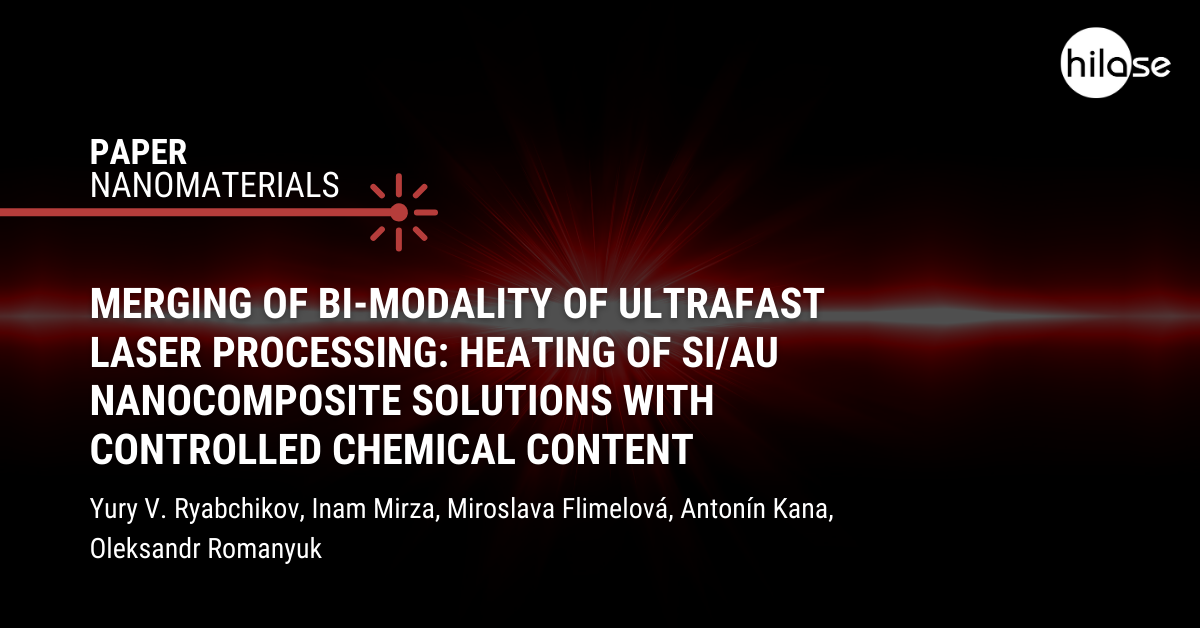HiLASIANS from the Scientific Laser Applications (SLA) department, Yury V. Ryabchikov, Inam Mirza and Miroslava Flimelová, published a new paper in the Nanomaterials journal. They have collaborated with Antonín Kana from the University of Chemistry and Technology, as well as Oleksandr Romanyuk from the Institute of Physics.

The research team synthesized ultrapure nanocomposites with controllable plasmonic properties using the “green” pulsed laser ablation technique. The efficiency of their plasmonic properties was tuned by their chemical composition studied by the ICP-MS method. The formed silicon-gold (Si-Au) nanocomposites revealed prospects not only in optical biosensing of pathogenic microorganisms using SERS, as it has been shown before but also in laser-induced hyperthermia, which can be promising for the destruction of this pathogen or cancer cells. This laser-based approach is suitable for different kinds of semiconductor nanoparticles with the aim of improving their performance.
Abstract
Ultrafast laser processing possesses unique outlooks for the synthesis of novel nanoarchitectures and their further applications in the field of life science. It allows not only the formation of multi-element nanostructures with tuneable performance but also provides various non-invasive laser-stimulated modalities. In this work, we employed ultrafast laser processing for the manufacturing of silicon–gold nanocomposites (Si/Au NCs) with the Au mass fraction variable from 15% (0.5 min ablation time) to 79% (10 min) which increased their plasmonic efficiency by six times and narrowed the bandgap from 1.55 eV to 1.23 eV. These nanostructures demonstrated a considerable fs laser-stimulated hyperthermia with a Au-dependent heating efficiency (~10–20 °C). The prepared surfactant-free colloidal solutions showed good chemical stability with a decrease (i) of zeta (ξ) potential (from −46 mV to −30 mV) and (ii) of the hydrodynamic size of the nanoparticles (from 104 nm to 52 nm) due to the increase in the laser ablation time from 0.5 min to 10 min. The electrical conductivity of NCs revealed a minimum value (~1.53 µS/cm) at 2 min ablation time while their increasing concentration was saturated (~1012 NPs/mL) at 7 min ablation duration. The formed NCs demonstrated a polycrystalline Au nature regardless of the laser ablation time accompanied with the coexistence of oxidized Au and oxidized Si as well as gold silicide phases at a shorter laser ablation time (<1 min) and the formation of a pristine Au at a longer irradiation. Our findings demonstrate the merged employment of ultrafast laser processing for the design of multi-element NCs with tuneable properties reveal efficient composition-sensitive photo-thermal therapy modality.
You can read the full study titled Merging of Bi-Modality of Ultrafast Laser Processing: Heating of Si/Au Nanocomposite Solutions with Controlled Chemical Content HERE.








